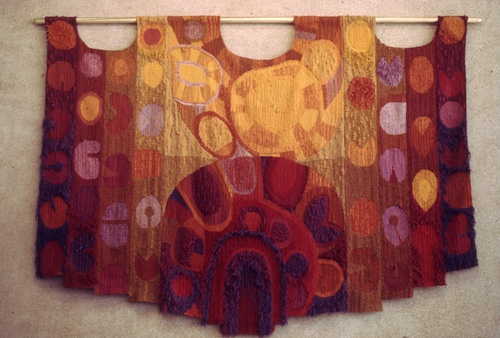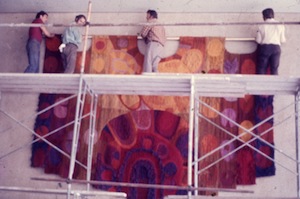Tapestry Commissions and Collections
 Wednesday, June 3, 2020 at 7:49AM
Wednesday, June 3, 2020 at 7:49AM 1976 "Darkness into Light" woven tapestry, hand dyed and some handspun wool on a cotton warp, suspended from a brass rod. Dimensions: 3.5m x 5m overall.
Chosen from a competition of five selected artists organised in 1975 by Architects Noel Bell Ridley Smith, for a large textile piece to hang in the newly built St Andrew's House, behind St Andrews Cathedral in Australia Square, Town Hall, Sydney.
At the time Sonia Delaunay and the Bauhaus were strong influences, as well as the vital abstraction of Aboriginal art. I was working on the design when I was co-ordinator of Tiwi Designs on Bathurst Island, Northern Territory in 1974. It took eighteen months to weave, made in three sections which were sewn together, and was installed in September 1976. It hung in the foyer of St Andrews House, visible from Australia Square, until about 2003 when it was decided to make a coffee bar in the foyer. My research assistant Lycia Trouton discovered it had been put in storage at St Andrew's Cathedral. Years later I had a request from St David's church in the Anglican Dioscese of Thirroul in Wollongong, to see whether thy might be able to repurpose it. I was very sad when the administrators of St Andrews Cathedral told me it had been lost, despite its great size and weight.

 Installing 'Darkness into Light' September 1976, St Andrews House, Australia Square, Sydney.
Installing 'Darkness into Light' September 1976, St Andrews House, Australia Square, Sydney.

